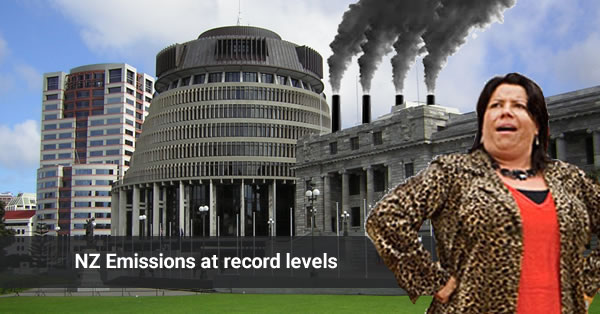Over the weekend the Government released the latest greenhouse gas emissions figures, which show our emissions are at record levels. This is mostly thanks to more cars, more cows, more fertilizer, and fewer trees.
We have committed to reduce emissions, and we know from the Paris Agreement that we have to get to net zero carbon emissions this century. So every time our emissions increase, we are increasing the costs and the difficulty of achieving that ultimate goal. So far the Government’s plan for dealing with climate change has been to buy credits from overseas (mostly fraudulent ones from the Ukraine and Russia) and rely on forests planted in the 1990s. These are only short-term fixes.
We urgently need experts working on a plan for how we can cost effectively reduce emissions, not more consultation as the Minister is suggesting. The government is late on to this and still just dragging the chain – now it’s cheating ways have hopefully come to an end.
Emissions by the numbers
Gross emissions (excluding forestry) are up 23% since 1990, though not quite back to their 2006 peak (they fell from 2006-2009 but have been climbing since). Net emissions (including the carbon soaked up and released by forestry) are up 54% since 1990 – and are now at their highest level ever. As we pointed out last year New Zealand is bucking the international trend – our emissions continue to rise while in 2015 the world’s dipped.
What factors are driving the changes? Energy emissions are up a whopping 36% since 1990, the increase coming mainly from road transport and electricity generation. Agriculture is up 15%, due to the national dairy herd increasing by 95% and nitrogen fertilizer use increasing more than five-fold (partially offset by the fall in sheep numbers). And crucially our forestry sector removed the least amount of carbon it has since 1990 – down 16%. This is because in recent years people have been chopping down forests to convert to dairy. This was only possible because the carbon price crashed to almost nothing – a direct result of the Government allowing our Emissions Trading Scheme to be flooded by cheap fraudulent international credits.
Increases make it harder to hit future targets
Remember our targets are to reduce emissions to 1990 levels by 2012, 5% below by 2020, 11% below by 2030 and 50% below by 2050. Given that we are still increasing emissions above 1990 levels, we now face a hugely expensive task to get emissions down.
Incredibly, the Government tries to excuse this negligence, arguing that it is more expensive for New Zealand to reduce emissions. As we have discussed previously, this expense is largely due to the fact that we have done nothing to reduce emissions so far. It is a bit like one of our athletes not doing any training for the Olympics, then blaming their coming last on someone else.
So far the Government has met targets through international units (most of which were fraudulent and environmentally worthless) and benefiting from pine forests planted in the 1990s before we entered the Kyoto Agreement. Forests are only a temporary solution, unless you keep planting more. Planting trees as Pure Advantage have suggested would be helpful, but only help buy us time. The same is true of the Government’s plan to keep buying international credits. Even if they are credible, we have to reduce carbon emissions to net zero sometime this century, so eventually we will have nobody to trade with.
We need a plan
Firstly we need to make up for the 97m fraudulent units we previously used to meet our obligations. We are projected to have 93m spare come 2020 – why not cancel these now and show we won’t continue to live off the proceeds of crime?
But longer term we need a plan. Minister Bennett accepts the need for a plan but in response has been talking about setting up a “taskforce”. Collaboration can be useful but only if it is well informed by research, represents all stakeholders and the consensus is implemented. Government has had taskforces on climate change before – the ETS Review Panel for one – but then ignored their recommendations. Even the recommendations of the Land and Water Forum are cherry picked. So the Minister’s suggestion looks like another talk-fest – all hui and no doey – a way of delaying action another few years when we should be getting on with it.
What we need isn’t more gas-bagging – it is research into the most cost-effective actions we can take to reduce emissions.
Other centre-right Governments know that in the long run it is cheaper to take action on reducing emissions now, such as the Conservatives in the UK. Under their Climate Change Act they have an independent Commission on Climate Change, which advises the Government on setting short-term milestones, developing plans and implementing them. Whoever is in charge, the government is legally required to have a plan, which provides some certainty for business.
Here’s Jim Skea from the UK Commission on Climate Change talking about how it works:youtu.be/4ipg5oxZEk4

